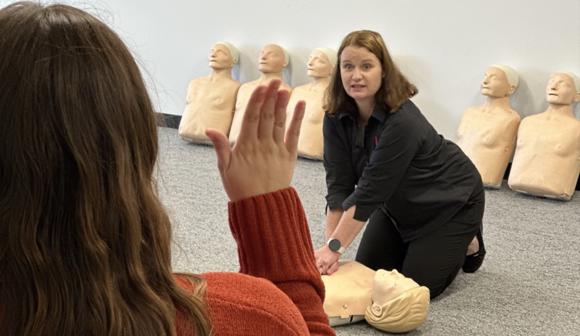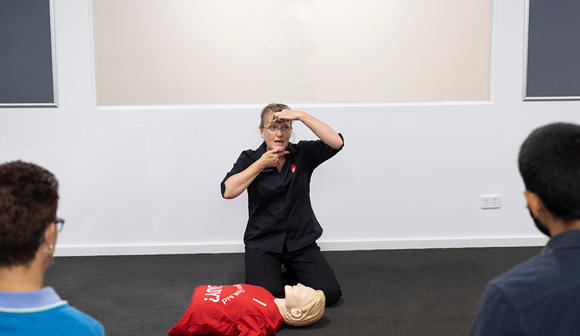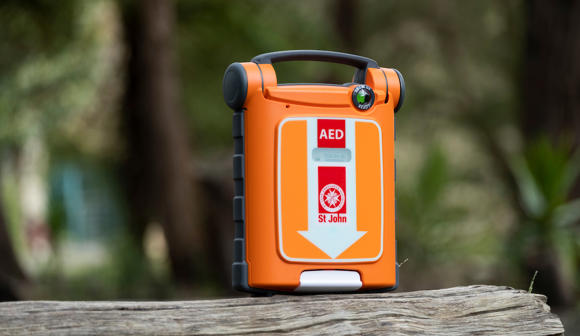7 Words That Will Save a Life – The DRSABCD
Warning: what you read here might save a life!
When it comes to basic life support, the first few minutes of an incident are critical. DRSABCD may sound complicated but ultimately, there are two things the body needs to survive – breathing and circulation. If the casualty can’t breathe, their organs will quickly suffer due to lack of oxygen in the blood. If their heart can’t pump oxygen around the body, the brain will die rapidly. All of the DRSABCD steps are focused on breathing and circulation.
So despite what other injuries the individual may have, which could be as severe as heavy bleeding, spinal injuries or even protruding objects, restoring their ability to breathe and the heart’s pumping function must come first.
Many casualties of motor vehicle accidents perish not from their injuries, but due to their inability to breathe when their head slumps forward and cuts off the trachea. This will often kill them faster than any injuries, with a window of only minutes to act once the airway is cut off. Many people are afraid to move the casualty’s head to allow air in for fear of causing spinal injury; however spinal injuries may not kill the casualty – whereas a lack of air definitely will. If bystanders know First Aid and can restore the airway, this will more than likely keep the casualty alive until help arrives.
These fundamental steps for providing basic life support are something that anyone can and should learn and implement.

D is for Danger
Is the area safe for you, others and the casualty? Before jumping to the rescue, assess whether the situation poses a threat due to conditions such as fire, gas, wires, obstacles or even toxic fumes. After all, you won’t be able to help the casualty if you become a casualty yourself.
Take a moment to check around the casualty for any potential dangers and then proceed.
R is for Response
Is the casualty conscious? If they aren’t responding you will need to take other action, so take a few steps to test if they can respond:
- Ask them their name
- Gently squeeze their shoulders
If they provide any form of response such as movement, noise or opening their eyes, the casualty is conscious and should be made comfortable. You can then attend to their other injuries.
However, if there is no response, move on to the next steps of DRSABCD.
S is Send for help
If they aren’t responding, an ambulance should be called – phone 000 or ask another person to call for you so you can move on to checking the casualty’s airway.
A is for Airway
If the casualty has something blocking their airway, they won’t be able to breathe freely and their survival will be compromised. Open their mouth to check if the airway is blocked by, food, vomit, blood or a foreign object.
If you find an obstruction, place them in the recovery position so you can better clear out the mouth with your fingers and let any fluids drain out, as this will be difficult to do effectively if they are lying on their back. Once it is cleared, check their breathing.
An airway can also be compromised if the casualty is sitting upright and their head is slumped forward (for example in a car accident). Lifting up their chin and moving the jaw forward will help them to breathe by maintaining an open airway.
B is for Breathing
Even once the airway is cleared, the casualty may not immediately be able to breathe. To check their breathing, look, listen and feel for 10 seconds. You can do this by placing a hand on their abdomen, an ear to their mouth and looking at your hand for the rise and fall that would indicate breathing.
An occasional gasp is not considered normal breathing. Two to three breaths in ten seconds is a good indicator of normal breathing.
If they are breathing, place the casualty in the recovery position. You should have already called 000 for an ambulance, but if not do so now.
Keep monitoring their breathing until help arrives, as they could stop breathing at any time and you will then need to be ready to start CPR.
If they are not breathing, ensure 000 has been called and start CPR.
C is for CPR
Cardiopulmonary Resuscitation, or CPR, will help a casualty that is not breathing, responding or moving to inflate their lungs with air and pump blood around the body via the heart.
CPR should follow the below steps:
- Give 30 chest compressions with two interlocked hands
- Tilt the head and lift the chin to give 2 breaths via the mouth, pinching the nose closed. Their chest should rise.
- Give a further 30 chest compressions
- Keep giving compressions and breaths at a rate of 30:2 until help arrives
If you find breaths are challenging to provide, performing only compressions on the chest will be better than no CPR at all. You do not have to give the casualty breaths to their mouth if you are in any way uncomfortable with this.
If you can, swap compressions with another First Aider to reduce fatigue. The transition should be done smoothly to ensure no interruption to CPR.
When to stop CPR:
- The casualty begins breathing and responding (place them in the recovery position)
- More qualified help arrives from an ambulance
- You are physically unable to continue
- If the situation becomes at all dangerous to you
Practising CPR at a recognised First Aid course or our CPR Lab will help you become comfortable with providing CPR, as you will get the opportunity to practice on our manikins, learn how much pressure to apply and the speed at which to perform compressions. Unfortunately, most people who only read instructions will feel unprepared to provide CPR should an incident occur, which is why we recommend everyone completes a First Aid course and regular CPR refreshers.
D is for Defibrillation
If a Defibrillator is available, send someone for it as soon as you start CPR.
It is important to apply the Defibrillator as soon as possible – for every minute that passes without defibrillation, the chances of survival drop by 9%. The machine will tell you what you should do via voice prompts as soon as it is opened or turned on. The instructions are clear and easy to follow and will repeat until you perform the required actions (placing the paddles on the chest, pressing the shock button, etc.).
The Defibrillator will detect if a shock is needed by analysing the heart’s electrical activity. It will not shock the casualty if this isn’t required.
CPR should be continued once a shock is delivered until the casualty starts breathing and responding.
These are the fundamental steps to follow for dealing with any emergency First Aid situation. The best way to ensure you will be ready and able to enact the DRSABCD steps when needed is to have an expert demonstrate exactly how to check for breaths and how to perform CPR at a Nationally Recognised First Aid Training course. There is no substitute for the confidence it will give you to take action and save a life.


HLTAID011 PROVIDE FIRST AID
Suitable for both people in workplaces and members of the public who would like a comprehensive first aid course.

HLTAID009 PROVIDE CARDIOPULMONARY RESUSCITATION
Learn the skills to perform life-saving (CPR) on an adult, child or infant who is unconscious and not breathing normally.

How to choose the right Defibrillator for you
Choosing a defibrillator can be hard. Read our list of things you should consider when choosing the right defibrillator for your needs.
